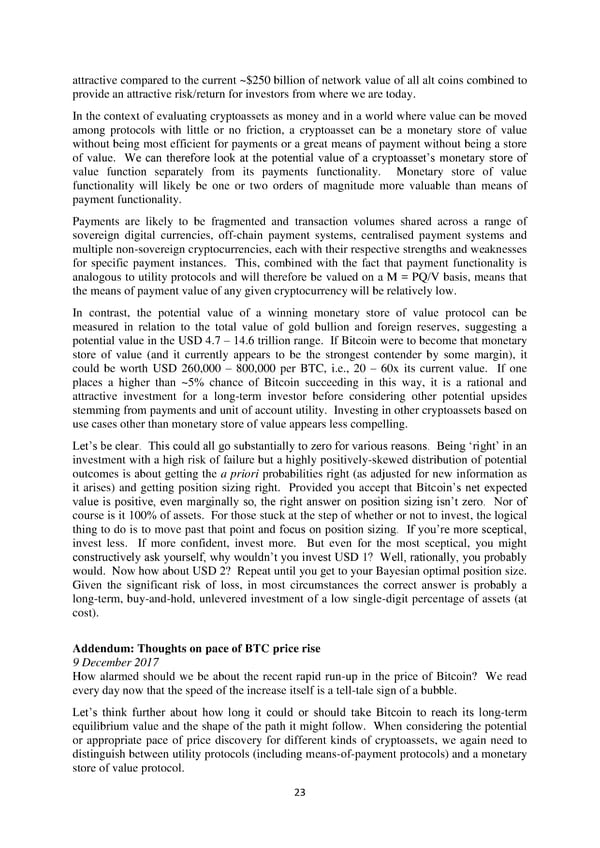attractive compared to the current ~$250 billion of network value of all alt coins combined to provide an attractive risk/return for investors from where we are today. In the context of evaluating cryptoassets as money and in a world where value can be moved among protocols with little or no friction, a cryptoasset can be a monetary store of value without being most efficient for payments or a great means of payment without being a store of value. We can therefore look at the potential value of a cryptoasset’s monetary store of value function separately from its payments functionality. Monetary store of value functionality will likely be one or two orders of magnitude more valuable than means of payment functionality. Payments are likely to be fragmented and transaction volumes shared across a range of sovereign digital currencies, off-chain payment systems, centralised payment systems and multiple non-sovereign cryptocurrencies, each with their respective strengths and weaknesses for specific payment instances. This, combined with the fact that payment functionality is analogous to utility protocols and will therefore be valued on a M = PQ/V basis, means that the means of payment value of any given cryptocurrency will be relatively low. In contrast, the potential value of a winning monetary store of value protocol can be measured in relation to the total value of gold bullion and foreign reserves, suggesting a potential value in the USD 4.7 – 14.6 trillion range. If Bitcoin were to become that monetary store of value (and it currently appears to be the strongest contender by some margin), it could be worth USD 260,000 – 800,000 per BTC, i.e., 20 – 60x its current value. If one places a higher than ~5% chance of Bitcoin succeeding in this way, it is a rational and attractive investment for a long-term investor before considering other potential upsides stemming from payments and unit of account utility. Investing in other cryptoassets based on use cases other than monetary store of value appears less compelling. Let’s be clear. This could all go substantially to zero for various reasons. Being ‘right’ in an investment with a high risk of failure but a highly positively-skewed distribution of potential outcomes is about getting the a priori probabilities right (as adjusted for new information as it arises) and getting position sizing right. Provided you accept that Bitcoin’s net expected value is positive, even marginally so, the right answer on position sizing isn’t zero. Nor of course is it 100% of assets. For those stuck at the step of whether or not to invest, the logical thing to do is to move past that point and focus on position sizing. If you’re more sceptical, invest less. If more confident, invest more. But even for the most sceptical, you might constructively ask yourself, why wouldn’t you invest USD 1? Well, rationally, you probably would. Now how about USD 2? Repeat until you get to your Bayesian optimal position size. Given the significant risk of loss, in most circumstances the correct answer is probably a long-term, buy-and-hold, unlevered investment of a low single-digit percentage of assets (at cost). Addendum: Thoughts on pace of BTC price rise 9 December 2017 How alarmed should we be about the recent rapid run-up in the price of Bitcoin? We read every day now that the speed of the increase itself is a tell-tale sign of a bubble. Let’s think further about how long it could or should take Bitcoin to reach its long-term equilibrium value and the shape of the path it might follow. When considering the potential or appropriate pace of price discovery for different kinds of cryptoassets, we again need to distinguish between utility protocols (including means-of-payment protocols) and a monetary store of value protocol. 23
 Investor’s Take on Cryptoassets by John Pfeffer Page 22 Page 24
Investor’s Take on Cryptoassets by John Pfeffer Page 22 Page 24